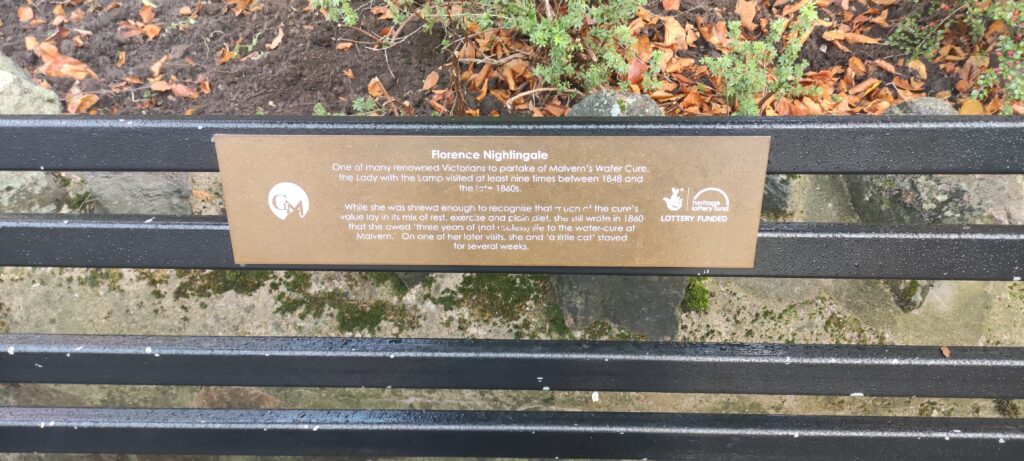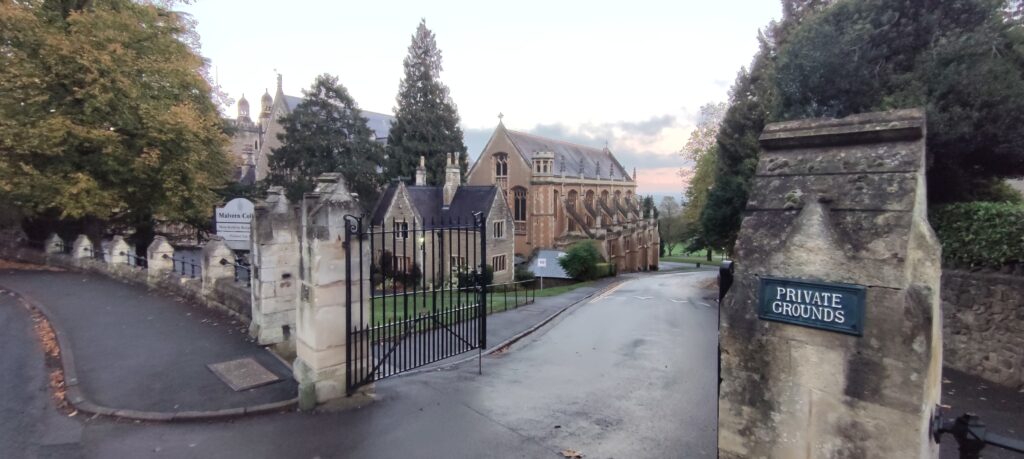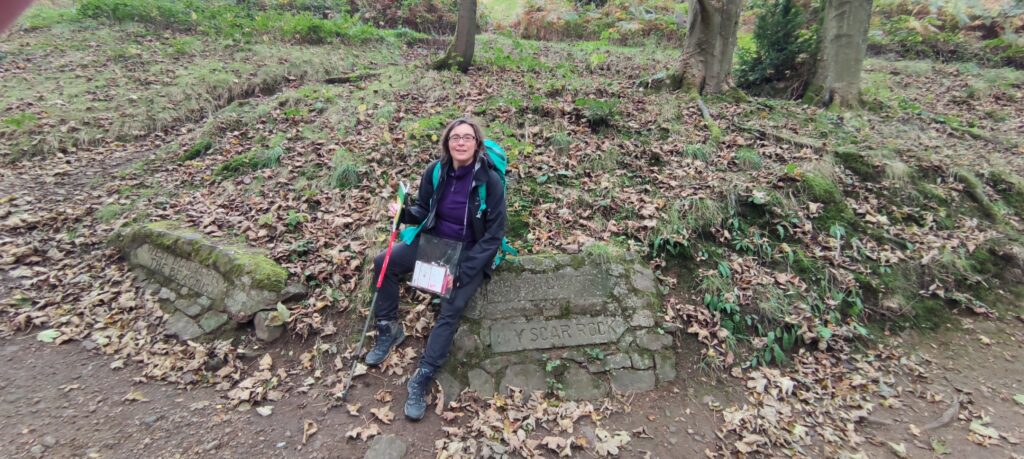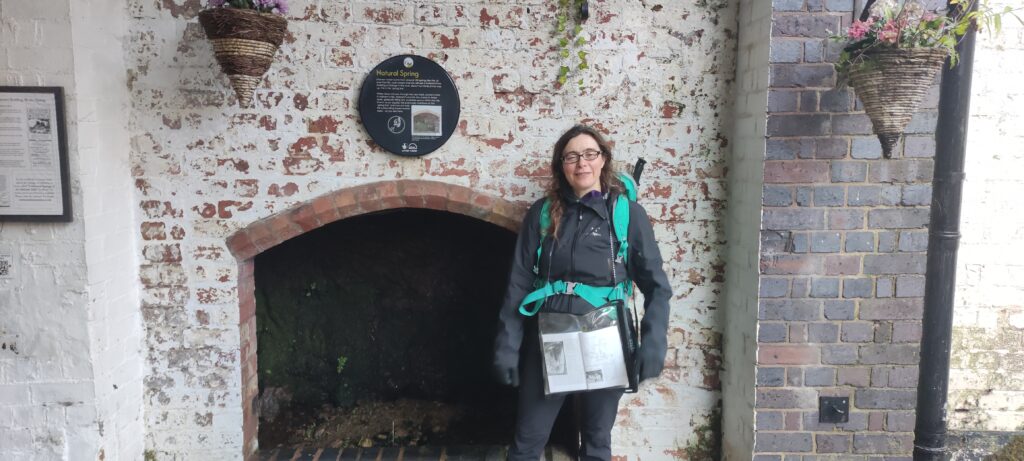- Start – Great Malvern
- Finish – Great Malvern
- Distance – 16km
- Time Taken – 5.5 Hours
Today was a game of two halves.

In the morning after a hasty coffee and pastry at Coffee #1 we drove to Great Malvern. The reason for the rush was because we imagined that like every other spa town we have ever visited there would be too many people and not enough parking spaces. This was a belief which was fulfilled even though it was a cold, windy and rainy day in late October. I dread to think what this place is like on a sunny Sunday in late July!

This morning, with the aid of Ordnance Survey book “The Malverns to Warwickshire – Outstanding Circular walks”, we go for a ramble in the Malvern Hills – Area of Outstanding Natural Beauty. What we find , at least to begin with, is a very carefully nurtured Victorian Wilderness, which reminds me a great deal of Jesmond’s Dene in Newcastle. The paths, though steep, are very neatly kept with clear signage made out of stone and litter bins pebble dashed and made to look like boulders. It is also busy, with traffic jams of walkers forming in the steeper narrower sections. A sharp contrast to yesterday when we saw nearly no-one else.
Eventually we come out of the woods and onto the tops of the ‘bare hills’. (The word Malvern is believed to derive from moel bryn meaning bare hill). There are beautiful views in all directions, from the Severn Plain in the East to the Mendips in the West.
We continue to climb eventually arriving at the summit of the Worcestershire Beacon.

This is the highest point in Worcestershire at 425m above sea level. The guide book tells us that “if you were to travel due East from the Beacon, no land of comparable height would be reached until the Ural Mountains”!

It is very windy on the summit and very busy, the amount of Gore Tex on show makes it look like a catalogue shoot for Cotswolds Outdoors!
As we start our descent we can see the whole line of the Malvern Ridge before us. There is a walk you can do from one end of the hill chain to the other, but it requires more logistic organisation than can be achieved in a trip booked 48 hours before departure.

As we walk back down to Great Malvern, the walk book takes us off the beaten track, which is a bit more fun 🙂 There are genuine precipitous drops, a few scrambles and steep slippy climbs, almost like being in the Alps 🙂
After 3 and a half hours and roughly 10km we get back into Great Malvern ready for our Sunday Lunch.

We are eating at the Mulberry Tree, the restaurant of the Mount Pleasant Hotel which was built in the middle 19th Century at the height of the Hydrotheraphy craze and used to house the patients visiting the springs.

The restaurant is spacious and the staff attentive. We start the meal with a simple, but delicious, bread and olive starter.

Craig follows this with the Mulberry Burger whilst I have the traditional Sunday Roast with all the trimmings. I am delighted to discover that it comes with copious amounts of vegetables and extra gravy!!
After a leisurely lunch we switched walking books to Ray Woodcock’s “Walk around THE MALVERNS” and embark on a tour of Great Malvern.

Great Malvern was, until the 18th Century, a small community centred around the attractive Priory of Malvern Magna.

So beloved was the Priory to the local community that they purchased it from Henry VIII rather than have it destroyed in the Reformation.
Another key feature of early life in Great Malvern are the quarries which had mined Malvern stone, a pretty pink volcanic granite, from Roman Times. All the quarries are closed due to environmental concerns and the only Malvern stone now used is reclaimed from older buildings.

They did also have a myriad of springs all over the local area which attracted a small amount of attention. In the 18th Century, a period when Bath, Leamington and even Harrogate were growing in fame and prosperity, Malvern Water was noted as being particularly pure but it wasn’t until 1842 that things really took off.
In that year Dr Wilson and Dr Gully set up shop in Malvern. Dr Gully in particular had come from Austria and introduced the town to Hydrotherapy or ‘the water cure’ . According to contemporary accounts people who undertook this cure were “wrapped in wet sheets at 6am for about an hour before being sent on a walk up to St Ann’s Well to drink the water before breakfast”
This cure was undertaken by many fashionable people, including Florence Nightingale, though the local history society credit her with understanding that the key to the ‘cure’ was fresh air and exercise.

Craig and I decided not to bother with the wet sheets, but we did walk up to St Ann’s Well and indeed visited several of the other town springs and tasted their wares – it tastes like water 🙂
Amongst many other nuggets of information we learned during our 2 hour, 6km tour of the town included that fact that CS Lewis was an Alumni of Malvern College – an impressive public school founded in 1865.

(Though clearly not nearly as impressive as Winchester College founded in 1382!) and that he also in later life visited the town many times to walk.

There is a suggestion that Malvern’s gas lighting system which even penetrated the lower parts of the woodlands may have inspired the classic lamp in the Narnia books.

We enjoyed our day in the Malvern Hills, though it was possibly a bit too theme-parky for our liking.
Tomorrow we are going home, with a slight diversion to Warwick University to surprise our middle child with a free lunch. All-in-all it has been an interesting glimpse into Worcestershire, and I think it is definitely worth another visit. Standing on the top of the Worcestershire Beacon with the County laid out before us, we could see so much more to explore.












There used to be a cafe on the top – I never saw it – it was a patch of scorched earth when I was up there. Probably better without it https://www.flickr.com/photos/14463685@N07/5836984875